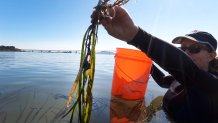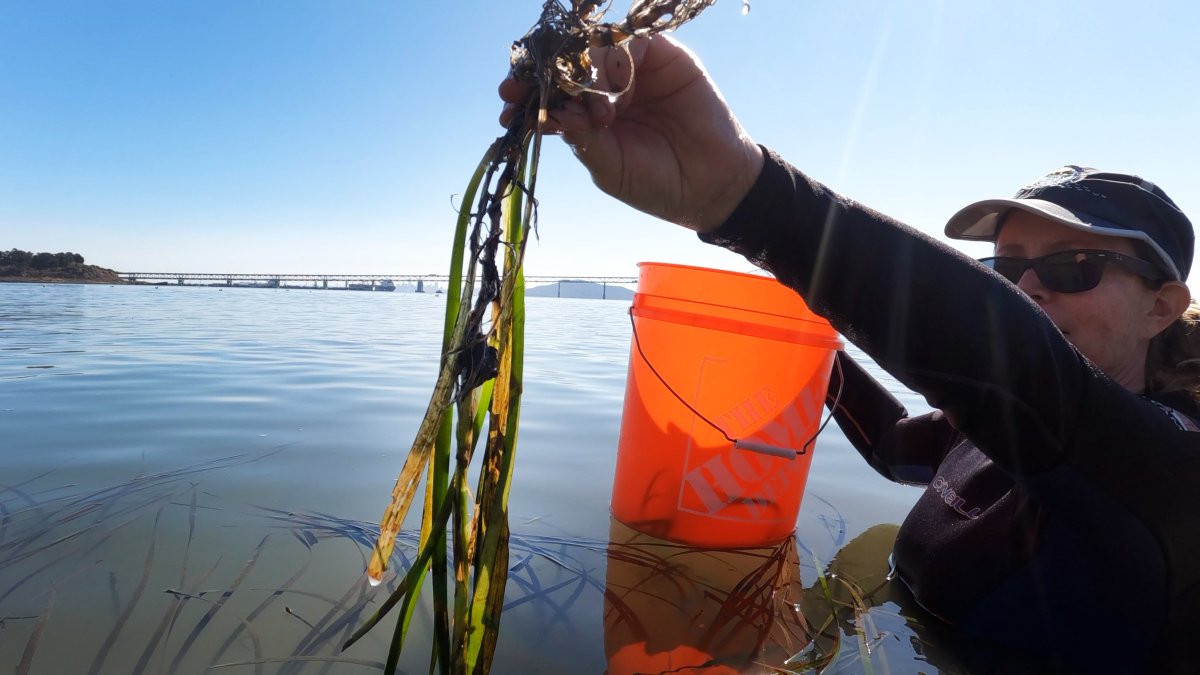When the tide rolls out along the shoreline of San Pablo Bay, plots of long, sinewy grass, known as eel grass, peak out from the water.
Researchers have long known these plots of grass as a favorite destination of all sorts of marine life – a place where Pacific herring lay their eggs or small smelt will hide from predators while eating even smaller fish. But just how many fish and creatures depend on eel grass is something of a mystery.
“We know that fish use these beds,” said Kathy Boyer, a scientist with the Estuary and Ocean Science Center who has studied eel grass for two decades. “But we don’t really know the details.”
In recent years, Boyer’s students have sought to find out more about the inhabitants of eel grass, which rings the entire San Francisco Bay, thriving in some areas over others. On numerous visits to the shoreline off of Richmond, in plain view of the Richmond-San Rafael Bridge, they pull long seine nets along the grass beds, gathering up the creatures who use them.

Joe Rosato Jr./NBC Bay Area
Joe Rosato Jr./NBC Bay Area
Researcher Kathy Boyer holds strands of eel grass off the coast of Richmond in the San Pablo Bay.
The nets commonly capture smelt, gobies, small shrimp, pipe fish and even on occasion leopard sharks and bat rays, which are all measured, recorded and released.
“They’re in the eel grass beds because it’s a place to hide from their predators,” Boyer said. “And it’s a place where they can get lots to eat.”
Eel grass beds extend beyond just a hangout spot for fish. They’re also an important resource for stabilizing shorelines, trapping sediment and countering ocean acidification — all symptoms of changing climate. But ironically, though eel grass plays an important role in addressing climate change, it’s also a potential casualty from it.
Daniel Orr of Audubon California pulled out an iPad to show computer models forecasting the future of eel grass beds around the Bay Area as a result of different climate change scenarios. The current model showed the bay ringed with green plots showing thriving eel grass beds. But under varying scenarios of sea level rise, rising water temperatures, and levels of salt in the bay, the plots of eel grass turned red.

Joe Rosato Jr./NBC Bay Area
Joe Rosato Jr./NBC Bay Area
Beds of eel grass float with the tides off the coast of Richmond in the San Pablo Bay.
“These redder areas are where you have a big loss of habitat,” Orr said pointing to the screen. “Maybe a 95% loss of habitat.”
A total loss of eel grass is unlikely, but Orr said the gradual loss of the beds under various climate change scenarios is still a big concern.
“If you did lose eel grass, you’re going to lose species, you’re going to lose other things, too,” he said. “It’s a nursery ground for commercially important and ecologically important species.”
Orr pointed out nearby Richardson Bay near Tiburon as a habitat where eel grass has thrived and should continue to do so even as climate change impacts other areas around the bay.

Joe Rosato Jr./NBC Bay Area
Joe Rosato Jr./NBC Bay Area
Researchers pull a seine net through eel grass beds in the San Pablo Bay to see which marine species use the beds.
“We’re learning and we’re trying to take advantage of that knowledge and get ahead of it,” Orr said.
While the eel grass situation might appear like one of those issues humans are unable to intercede, Boyer said that’s not the case. Since 2014, her research groups have harvested some of the eel grass plants from the San Pablo Bay and replanted them in areas around the entire bay with hopes they’ll take root.
“We’re doing somewhere between five and 10 acres of eel grass restoration per year in San Francisco Bay now,” Boyer said.
Although some 80,000 drivers a day skirt past the Richmond shoreline via the Richmond-San Rafael Bridge, the issue of eel grass isn’t a household concern – something Boyer understands.

Joe Rosato Jr./NBC Bay Area
Joe Rosato Jr./NBC Bay Area
Researcher Kathy Boyer holds up a bucket of eel grass collected in the San Pablo Bay.
“It is hard for people to recognize its value because they have trouble seeing it,” she said. “It’s usually under the water.”
While the grass itself, its tendrils moving with the tide, is out of public view, Boyer hopes the awareness of the eel grass and its importance will rise to the public’s interest.
Just 20 yards down the shore from Boyer, her student research team was pulling in a seine net and sorting through its contents. The take produced more small smelt, a single shrimp and a nearly 2-inch goby fish. Soon the creatures were dumped back in the bay to once again take refuge in a cluster of eel grass.
“Understanding a bit more about the value of these beds helps us to protect them,” Boyer said.
